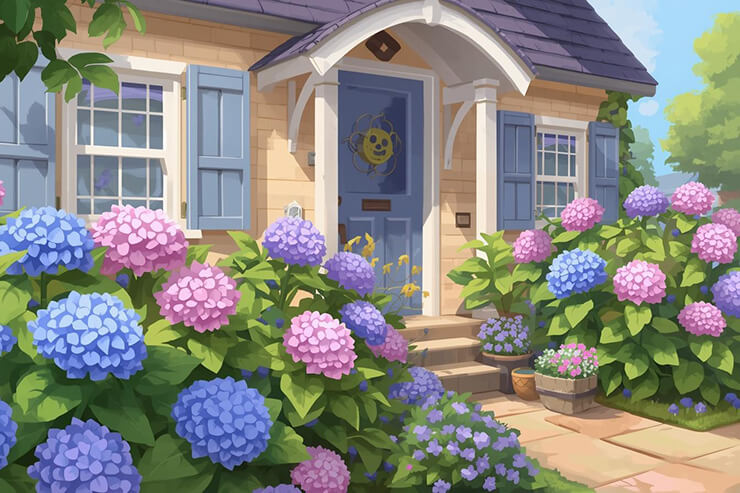Read by Michael Flamel

(with apologies to Rodgers and Hammerstein)
I remember it like it was yesterday.
Wait a minute. I don’t remember yesterday. I remember the day in 1962 when I was trying to reach inside a gumball machine from underneath to try and grab a George Reeves/Superman flicker ring and got my hand stuck, but not yesterday.
At any rate, it was many decades after ’62 (never did get that ring), and specialty plant companies were sending me their new introductions to “test,” little knowing that the report cards I issued were graded pass or fail, live or die was, after all, the ultimate plant hardiness test as far as I was concerned—and it made my remarks easy to fit into their promotional advertising.
Other (real) reviewers would say things like “beautiful large crimson blooms that persist longer than one might expect with the species.” Yawn. I wrote exciting endorsements like, “My God! It’s still alive!” (Am I looking at the wrong plant?) And, “What color was this supposed to be?”
As the truck that foolishly delivered my helpless hydrangeas was pulling away, I swear I could hear faint voices softy screaming from the garden bed behind me, “No! Please! Don’t leave us here!”
Then I turned to the plants and soothingly said, “It’s okay! You’re already doing great! It’s been a whole twenty minutes and you’re not dead yet! Keep that up until tomorrow and you’ll set a new survival record in the garden!” They did not seem to be comforted by these assurances.
And try as they might, they were not able to make their low-volume calls of “Help! Help!” audible to passersby. Although some neighbors did come to the door to report that while walking past, they thought they heard calls for assistance from what sounded like the tiny, winged creature in the final scene of the 1958 film “The Fly.” (20th Century Fox; screenplay by James Clavell) (Really.)
Realizing that they would get no help from me or the dog-walkers, the hydrangeas resigned themselves to what would almost certainly be a short and treacherous life. But, to everyone’s surprise, they grew well—possibly thanks to the six inches of aged mushroom soil I had spread near them because I didn’t have anywhere else besides the front yard to toss the last of the 10 tons I had kind of foolishly ordered for my 1,000-square-foot raised-bed garden. I was always bad at math. Still takes me 20 minutes to correctly draw a five.
(And that’s thanks to the grade-school teacher who showed me how to draw that infernal number as a stick fixture.) “Man walks down the street, turns around the corner, and his hat blows off.”
I know. I should get federal money.
The hydrangeas were planted in a row of three, pretty much directly underneath a front gutter that would have been no help, but I kept forgetting to clean out my gutters, and they became unintentional horticultural displays (“Look! There’s a white pine growing up there!”) especially in the front, that also acted as an indirect overflow watering system. And, on the rare occasions I did clean them out, the plants directly underneath received large amounts of COMPLETELY finished aquatic compost. (Cattails grew out of some sections. And, I found a frog up there one year.)
They got some sun in the morning (Surprising, as all sides of my home face north.) but once that small amount of sun passed over the house, they were forced to endure, at best, “dappled shade” (Latin for you need a flashlight.)
Apparently, hydrangeas enjoy growing in dark swamps—like jungle vines and The Creature from the Black Lagoon (who apparently had a very nice display garden).
As with most of this genus of plants, my hydrangeas bloomed wonderfully some years, poorly some years, and not at all. But in the last decade or so, my public radio show received an increased number of calls about “no blooms on my hydrangeas,” and I decided to double-reconsider my answers on this topic as I mostly responded by asking, “Why did you prune them then?!”
The more-than-frequent response from listener/caller was. “I was bored.” My response to that admission was generally something like, “Your pruners should be hidden and your hands duct-taped together!” And, that’s if I was in a good mood.
Yes, my standard answer was poor pruning. I had always let my garden’s flower heads “persist”, following the Martha Stewart advice of leaving such things standing for “Winter interest”—meaning you had something to look at when you didn’t have anything else to look at besides giant inflatable Homer Simpsons and strings of mostly burned-out lights, half of which were touching the ground.
Besides, those seedheads provided an abundance of natural food for Winter birds, which is why we used to allow a wall-to-wall lawn of baby hosta every Spring. (It’s a shade plant! It’s a sun plant! It’s a ground cover!)
(We finally learned to weed-whack paths through the emerging hosta forest early in the season and then shape little islands here and there so it would look deliberate and maybe the neighbors wouldn’t complain so much.)
But I finally decided that the sight of the dried-up, claw-like, spent hydrangea flowers provided “interest” only around Halloween, when we spread reusable fake spider webs on top of them with blinking red lights inside the shrubs.
My general advice to cushion the visual effects of horticultural failures is to move things around so it looks deliberate. “Hey—nobody’s gonna know what it was supposed to look like, so move that statue over in front of here.” (My version of a “Hints of Heloise”.)
Anyway, there was no way to make this scene look festive after November. (Unless we bought an inflatable Jack Skellington and went for a “The Nightmare Before Christmas” look, which I’m sure the neighbors would have loved. “More rubber spiders over here, Santa!”) Instead, we wisely dead-headed the claws and allowed the plants to achieve that classic‘one season of interest look (which was still half-a-season longer than my flowering crabapple).
But that was then (and still now), and the reason for no or reduced blooms on hydrangeas now includes climate craziness. Early frosts in the Fall (followed, of course, by a heat wave or two) or a late freeze (in say, June) moved into a tie for bud destruction. (At least you still had semi-attractive leaves. C’mon, work with me here.)
But poorly timed pruning was still in the cards. Displays (or what would have been displays) of Spring blooming plants are always harmed by gardeners who foolishly follow the oft (and awful) advice to “Clean up the garden in the Fall,” and thus cut off all of next year’s flowers. (“Bad garden advice is like a herd of cockroaches; there’s millions of them, and they’re hard to kill.”)
Hey kids! Make sure to compost all those would-have-been flowers you removed!
So, we can’t control the weather (Heck, even the weather can’t seem to control the weather.), but we can try to avoid poorly timed pruning. And that’s easy to correct, right? You prune Spring bloomers right after they finish blooming; and you prune Summer bloomers at the beginning of Spring!
But wait a minute—hydrangeas (at least the ones in my garden) don’t bloom until after the Spring bulbs and forsythia are spent. And, their flowers appear long before the late-blooming Rose of Sharon and crepe Myrtle remind you that they aren’t dead after all. When DO hydrangeas set their buds?
To quote a possibly unreliable Internet source: “Hydrangeas set their flower buds at different times depending on the variety. Bigleaf and oakleaf hydrangeas form flower buds in late summer and early fall on old wood (growth from the previous year), while panicle and smooth hydrangeas form buds in spring on new wood (growth from the current year).”
And I hoped there wouldn’t be any math today.
Years ago, I was discussing this problem with the head of one of our local botanic gardens (can’t remember which one—there’s too many of them! At least three more than the number of kids on “The Waltons”…) and we agreed that one possible solution would be to wait until all the flowers were open and then cut back the stems that weren’t producing so you could see more of the blooms.
Not sure if that was a good idea or not (especially as my oakleaf hydrangeas bloom in late Spring) but the “wait until after the flowers appear” technique seemed to work (pause)…until…
This Spring, while I was still recovering from my Winter scurvy, and had not yet completely left the hazy confines of “The Twilight Zone” (Submitted for your approval: a slightly dazed gardener, pruners in hand, standing in front of a line of just-awakened hydrangeas, muttering “Is it I after C except after a traffic stop?” or “Never trust a naked bus driver.”
It is one of life’s eternal questions. Nature or nurture? Is there intelligent life in the Universe? And, should I use these pruners or go inside and read coverless comic books from the 1960s?
Rod Serling voice again: “It is a question that will later be answered by an explosion of teeny-tiny hydrangea flowers; none bigger than a quarter. Because that’s how the hydrangea grows…
…in the Garden Zone.” ❖


 Previous
Previous



I have a hydrangea in the front year of my townhouse, I’ve pruned it the way I want it. Darn it, if the Gardener doesn’t come a long and cut off the buds every year!
I still don’t know when to prune my hydrangeas ????
Please refer to our Hydrangea Guidebook https://foodgardening.mequoda.com/articles/comprehensive-guide-to-hydrangea-care-basics-nurturing-your-hydrangea-garden/